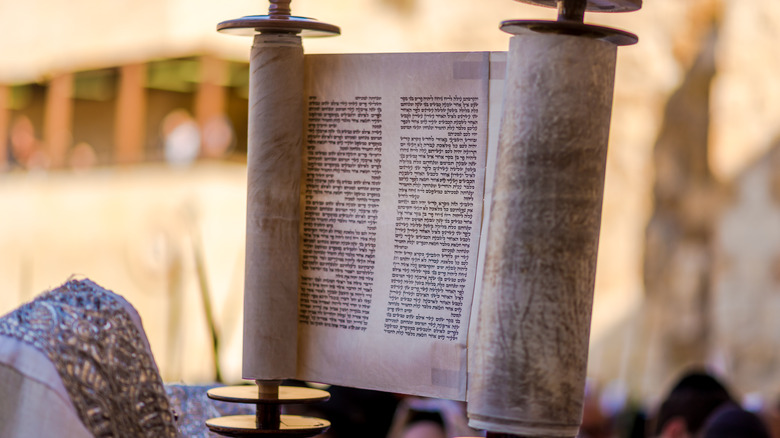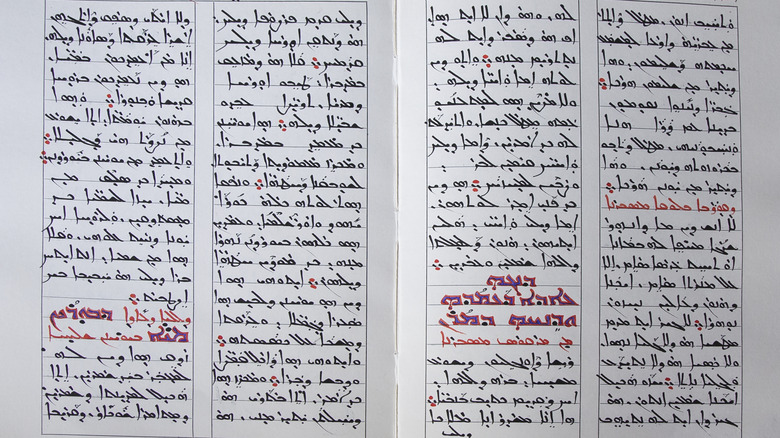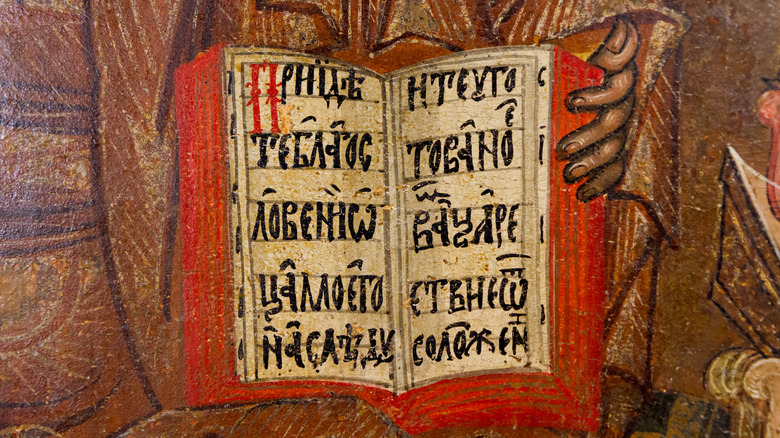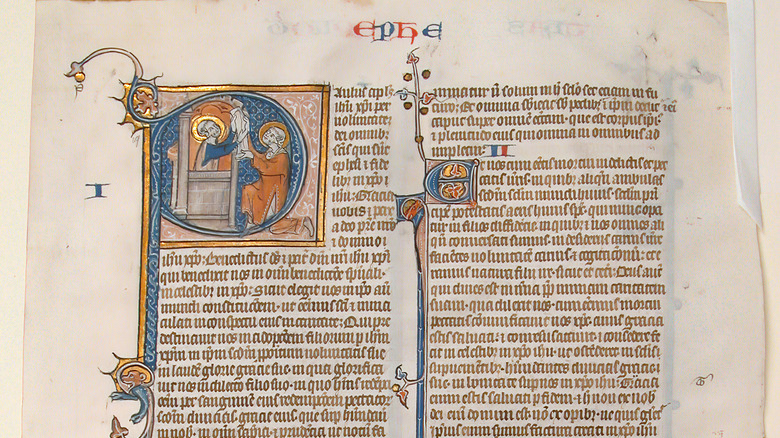Here Are The Languages First Used To Write The Bible
As Wycliffe Bible Translators reports, the Bible has been translated into the world's major first languages — English, Mandarin, Spanish, etc. — and so many of the world's minor ones that, for four in five of the world's people, the sacred text is available to them in their mother tongue. Of course, this excludes issues such as persecution and the illegality of possessing certain religious texts in select parts of the world — a matter that won't be discussed here.
For centuries, however, being able to read and understand the Bible was a privilege reserved only for a select few: those who had spent years, if not decades, learning ancient languages. Bible translation into the local language (whichever that may be) didn't really begin in earnest until the middle of the second millennium, and even so, it was often done at great cost to the translator.
Meanwhile, the languages in which the Bible was originally written occupy a unique place in the study of linguistics. One of them died out, was revived, and is today spoken by millions of people; one survived the centuries and is spoken by a small community; and one remains an academic discipline that, centuries later, is still studied to this day.
The Bible was written in Hebrew, Aramaic, and Greek
The Bible was not written down all at once by one person. It was written — and according to some accounts, copied and edited and compiled — over centuries by different people living in different places and in different cultures. The majority of the words of the Bible were written in Hebrew. In fact, according to Word Counter, the King James Bible (an English translation) contains just over 3 million letters, or about 73% of the Bible's text. In other words, according to this over-simplified mathematical thought experiment, nearly three-fourths of the Bible was written in Hebrew.
However, a few passages in the Old Testament were written in a companion language to Hebrew: Aramaic. A linguistic cousin of Hebrew, this language accounts for a few passages in Daniel, Ezra, and Jeremiah. According to TruthOnlyBible, these passages were possibly added by later editors decades after the rest of those books were written. Further, a few Aramaic words and phrases also pop up here and there in the New Testament, according to Baker Publishing Group.
Finally, the overwhelming majority of the New Testament — save for the aforementioned Aramaic bits — was written in Ancient Greek, according to the International Bible Society.
Hebrew died and was revived
By the time the writers of what would come to be called the Old Testament began putting pen to paper, the dominant language was Hebrew. As Bible Gateway explains, the language is an ancient Semitic tongue believed to have originated before 1500 B.C. For centuries, the authors who would write, edit, and compile the documents that were eventually grouped into the Old Testament wrote and spoke Hebrew, and that's the language they used to write their scripture.
Due to a series of historical events that won't be rehashed here, by the fourth century, Hebrew was completely dead as a language, existing only as words on scrolls. However, as Lang Focus explains, a concerted effort was made in the 19th century to revive the language, and to this day, it's spoken by millions of people around the world (mostly in Israel and the Middle East). However, the outlet also notes that Modern Hebrew and Ancient Hebrew aren't exactly the same and compares this contrast to the divide between the English of the King James Bible and the English spoken every day by modern speakers; it's possible to get the gist, but word usage, syntax, and grammar are often different and confusing.
A few thousand people still speak Aramaic
The writers of the Bible lived among other tribes and nations and were involved in trade with not only one another but other far-flung locales. As such, it should come as no surprise that languages mixed, developed, and grew in much the same way that they do today. To that end, by 700 B.C., another language had crept into the vernacular of many of the people connected to Old Testament history: Aramaic. Described by TruthOnlyBible as a cousin to Hebrew, the language takes up so little of the language of the Old Testament (save for a few hundred verses here and there) that it was all but forgotten about by Biblical scholarship.
However, Aramaic never actually went away. According to The Times of Israel, a few hundred thousand people across the world still speak the ancient tongue. Nevertheless, the newspaper notes that in much the same way that a speaker of Modern English wouldn't understand more than a few words of a passage by Middle Ages poet Geoffrey Chaucer, a Modern Aramaic speaker would be hard-pressed to understand so much as a word that Jesus spoke (Aramaic would have been his spoken language). Like similar languages spoken by comparatively few people, linguists are concerned that the language's days are numbered without heroic preservation efforts.
Ancient Greek is probably understandable to Modern Greek speakers
Save for a handful of colloquial Aramaic words and phrases scattered across the text, the overwhelming majority of the New Testament was written in an ancient form of Greek known as Koine Greek ("koine" means "common"). By Jesus' time, the Greeks — through centuries of diplomacy, trade, and military conquest — had made their culture and language the dominant way of life across much of the Middle East and Far West Asia, per Bible Study. As such, the writers of the New Testament knew that they would expand their reach by writing in a language that would be understood by more readers than if they had written it in their own first language (likely Aramaic or Hebrew).
As you are well aware, Greek is not a dead language. According to Babbel Magazine, it's spoken by over 10 million people to this day. So are Ancient Greek and Modern Greek mutually intelligible? Yes, says Greekpod101 contributor Stefania. She notes that Greek teenagers must study Koine Greek in high school, and Modern Greek retains a similar syntax — as well as quite a few similar words — to its ancient ancestor. The system isn't perfect, and many Greeks struggle with the dichotomy, but in the main, Stefania says educated Greeks get the gist of Biblical Greek.
What about Latin?
For centuries, Latin was the dominant — nay, the only — language used by Christians across Europe, according to Canon Law. Indeed, in Catholicism, the Church didn't fully transition from conducting rites in Latin to in the local language until the 20th century. However, you may be surprised that Latin's role in the Bible is downright trivial.
As mentioned above, at the time of the New Testament, Greek was the go-to language for communicating with a wide range of people with different first languages. And though the Romans exerted influence on the region at the time the text was written, their language played the most minor of minor roles in the development of the New Testament. Specifically, according to Butler University, only a couple dozen Latin words and phrases appear in the New Testament, and the words were transliterated from Latin into Greek. This conversion mirrors how English speakers say "sushi" and spell it with Roman letters. Examples of such words in the Bible include military titles ("centurion"), coins ("denarius"), and similarly mundane things that may have been a part of the daily life of the reader at the time.





